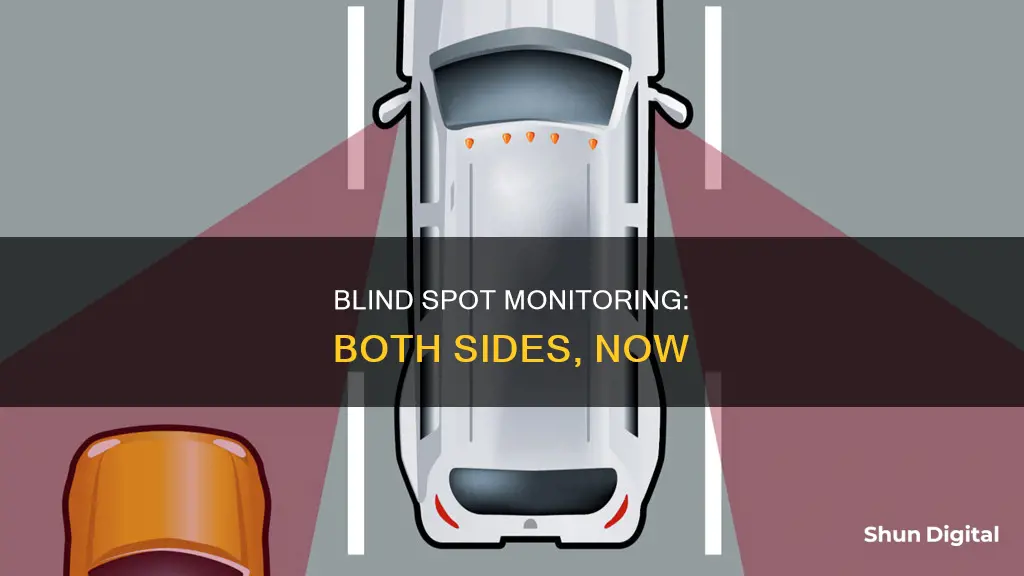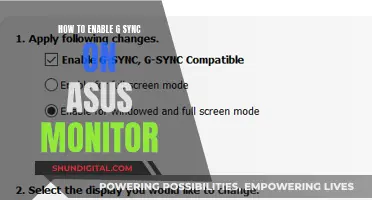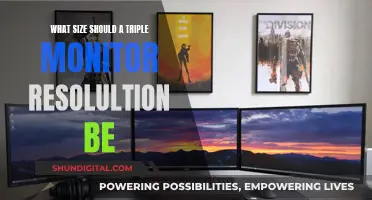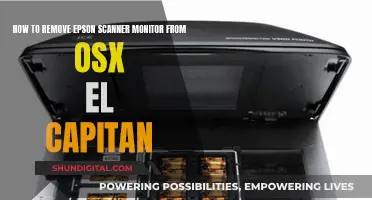
Blind spots are areas on either side of a car that the driver cannot see when looking into the rearview or side-view mirrors. Blind spot monitors are safety features in cars that can detect when another vehicle is in the driver's blind spot. They use sensors in a vehicle’s rear bumper and/or side mirrors to detect when another vehicle is approaching and from which side. While blind spot monitors are not a substitute for checking mirrors and looking over one's shoulder, they offer an added safety measure to compensate for human error. They can also help prevent crashes. So, do blind spot monitors monitor both the passenger and driver sides?
| Characteristics | Values |
|---|---|
| Purpose | Detects other vehicles in a driver's blind spot |
| Sensor Placement | Side mirrors, side of the vehicle, or rear bumper |
| Alert Types | Visual, audible, vibrating, or tactile |
| Alert Placement | Side mirrors, A-pillar, driver-information display, or head-up display |
| Additional Features | Rear Cross-Traffic Alert, lane-keeping assistance, steering assistance, automatic emergency braking |
What You'll Learn
- Blind spot monitors can be added to older vehicles as an aftermarket product
- They can alert the driver through visual, audible, vibrating, or tactile warnings
- They are designed to reduce accidents and increase driver awareness
- Blind spot monitors are not always 100% effective
- They are not a substitute for checking mirrors and looking over your shoulder

Blind spot monitors can be added to older vehicles as an aftermarket product
Aftermarket blind spot monitoring systems are available in a range of prices and qualities. The most affordable systems cost $250 and under, while mid-range options go for $250-$500, and high-end systems cost $500 or more. The more you pay, the more accurate and reliable the system is likely to be.
Most aftermarket blind spot monitoring systems are universal, meaning they can be used regardless of the age, make, and model of your vehicle. However, some systems are custom-designed for specific vehicles. These custom-designed kits are offered by a growing number of companies, including start-ups and major auto parts manufacturers.
The main components of an aftermarket blind spot monitoring system are the sensors and the indicators. The sensors use technologies like radar, sonar, and lidar to detect hazards in the vehicle's exterior environment. Cameras inserted into the side mirrors can also relay information to a computer. Once the sensor detects something, it triggers the indicator, which alerts the driver. Indicators typically include visual LED lights and an alarm, and some systems allow you to control the volume of the indicator.
While it is possible to install an aftermarket blind spot monitoring system yourself, professional installation is recommended. The process can be fairly involved, and a professional will ensure that the system is set up correctly and functions properly.
Mounting LCD Monitors: Ergo Arm Installation Guide
You may want to see also

They can alert the driver through visual, audible, vibrating, or tactile warnings
Blind-spot monitoring systems are designed to alert the driver of vehicles that may be in their blind spots. These alerts can come in the form of visual, audible, vibrating, or tactile warnings. Visual alerts are typically flashing lights or illuminated icons in the side-view mirror, gauge cluster, or head-up display. They are designed to be easily seen by the driver without having to look away from the road.
Audible alerts are usually in the form of beeping tones or repeating chimes, which can be customized in volume to ensure they are noticeable without being startling. Some systems also offer haptic alerts, such as vibrations through the steering wheel or seat, providing a tactile warning to the driver.
The combination of these alerts helps ensure that the driver is made aware of potential hazards in their blind spots. It is important to note that blind-spot monitoring systems are not a replacement for checking mirrors and looking over one's shoulder, but they do provide an added layer of safety to compensate for human error.
The alerts are triggered when a vehicle, or in some cases, a motorcycle or pedestrian, enters the blind spot or when the driver activates the turn signal while another vehicle is in the blind spot. By providing timely warnings, these systems increase the driver's awareness and allow for a quicker response to potential dangers.
The effectiveness of blind-spot monitoring systems is supported by research. According to the Insurance Institute for Highway Safety, cars equipped with these systems are 23% less likely to be involved in injury-causing crashes. Additionally, it is estimated that if all vehicles had blind-spot monitors, approximately 50,000 crashes and 16,000 injuries could be prevented annually.
Updating ASUS Monitor Drivers: A Simple Step-by-Step Guide
You may want to see also

They are designed to reduce accidents and increase driver awareness
Blind-spot monitoring (BSM) is a safety feature designed to reduce accidents and increase driver awareness by alerting drivers to vehicles that may be hidden in their side or rear blind spots. BSM uses sensors and sometimes cameras to detect vehicles in adjacent lanes, and alerts the driver with visual, audible, vibrating, or tactile warnings.
BSM is particularly useful for larger vehicles, which tend to have bigger blind spots. It can also be bundled with a rear cross-traffic alert feature, which detects vehicles, objects, or pedestrians when reversing out of parking spots.
While BSM is a valuable safety tool, it is not a substitute for checking mirrors and looking over one's shoulder before changing lanes. Drivers should be aware of its limitations, such as its difficulty in detecting motorcycles or vehicles travelling at high speeds.
Aftermarket BSM kits are available for older vehicles that do not have this feature built-in. These kits typically include sensors and indicators, with warning lights and audio alarms.
Asus Monitors: Are Built-In Cameras a Feature?
You may want to see also

Blind spot monitors are not always 100% effective
Firstly, it is important to note that blind spot monitors are designed to detect vehicles, not pedestrians, cyclists, or animals. This means that even with a blind spot monitor, you could still collide with a person or object that is not a vehicle. Additionally, these systems are not foolproof and may fail to detect vehicles in certain situations or conditions. For example, if the cameras and sensors are not properly cleaned and maintained, their effectiveness may be reduced.
Furthermore, blind spot monitors are typically designed to monitor the sides and rear of the vehicle, but they may not cover all areas, leaving some blind spots that the driver must check manually. While some advanced systems may include a "Rear Cross-Traffic Alert" feature, which can be helpful when backing out of parking spaces, it is still crucial for drivers to remain vigilant and aware of their surroundings.
Another factor to consider is that not all vehicles have blind spot monitors, and even if they do, the system may not be activated or properly set up. This means that as a driver, you cannot always rely on the presence of a blind spot monitor to ensure your safety. It is important to maintain proper driving habits, such as regularly checking your mirrors and blind spots, regardless of whether your vehicle is equipped with a blind spot monitoring system.
Lastly, while blind spot monitors can provide warnings through visual, audible, vibrating, or tactile alerts, the driver must still take appropriate action to avoid a collision. The effectiveness of the system depends on the driver's response to these warnings. Therefore, blind spot monitors should be used as a supplementary tool to safe driving practices, not as a replacement for them.
Monitoring Rogers Internet Usage: Tips for Staying Informed
You may want to see also

They are not a substitute for checking mirrors and looking over your shoulder
Blind-spot monitoring (BSM) is a useful safety feature that can help prevent accidents, but it is not a substitute for checking mirrors and looking over your shoulder. While BSM can alert you to potential hazards, it is important for drivers to remain cautious and aware of their surroundings.
BSM uses sensors and sometimes cameras to detect vehicles in a driver's blind spot, which is the area not visible in the side-view or rearview mirrors. This technology can be especially helpful for larger vehicles with bigger blind spots, as well as when driving on highways. However, it is important to note that BSM systems usually have minimum and maximum speed limits for detection, and they may not always detect smaller vehicles like motorcycles.
While BSM can provide an early warning and increase your driving awareness, it should be used as a supplementary tool rather than a replacement for safe driving practices. Drivers are still liable for blind spot crashes, even if they have BSM installed. It is crucial to check mirrors, use turn signals, and look over your shoulder before changing lanes or merging. By combining BSM with cautious driving, you can enhance your safety on the road.
Additionally, BSM systems require proper care and maintenance. The sensors and cameras must be kept clean and free from obstructions like snow, ice, mud, or dirt. Regularly cleaning and maintaining the BSM system will ensure its optimal performance.
In conclusion, while blind-spot monitoring is a valuable safety feature, it should be used as an additional layer of protection rather than a replacement for safe driving practices. By using BSM in conjunction with mirror checks and shoulder checks, drivers can maximize their safety and minimize the risk of accidents.
Monitoring Data Usage: Wireless Router Tips
You may want to see also
Frequently asked questions
Blind spot crashes are one of the most common types of auto accidents. While blind spot monitors are not yet required, they can be helpful in preventing crashes. According to the Insurance Institute for Highway Safety, cars with blind spot monitoring systems are 23% less likely to get into injury-causing crashes.
Blind spot monitoring systems use sensors in a vehicle’s rear bumper and/or side mirrors to detect when another vehicle is approaching and from which side. If another vehicle is approaching your blind spot, or if you activate your turn signal while another vehicle is in your blind spot, the blind spot monitoring system will issue a warning. This is usually an indicator light with a warning chime, but can also be an audible, vibrating or tactile warning.
Blind spot monitoring is now offered across the market, not just on luxury vehicles. You can expect to pay $300 to $500 for a solid aftermarket system.







